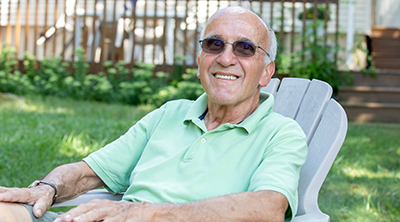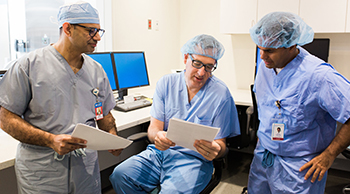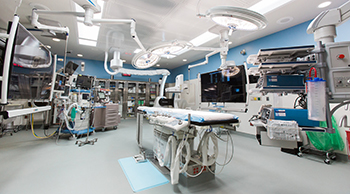
Stephen Gulyas suffered from a heart condition that caused him to become fatigued with tasks requiring minimal energy. After having a transcatheter aortic valve replacement (TAVR) procedure at Bridgeport Hospital, he enjoys being active again.
A fresh start with a better heart, thanks to Bridgeport Hospital’s Heart and Vascular Center
During the spring of 2017, Stephen Gulyas Jr., 73, of Fairfield, could not tie his shoes.
“I would bend down to tie my shoes and would be out of breath,” explained Gulyas.
With Gulyas’s history of heart issues, he knew why he felt ill.
It was the late 1990s when Gulyas’s primary care physician detected a heart murmur during his physical exam. The physician referred him to cardiologist Mitchell Driesman, MD, with Bridgeport Hospital-affiliated Northeast Medical Group’s Cardiac Specialists.
Dr. Driesman monitored Gulyas for years, but his condition worsened over time. In April 2002, at the age of 58, Gulyas needed his aortic valve replaced due to aortic valve stenosis, the calcification and narrowing of the valve’s opening. He decided to have open-heart surgery to replace his aortic valve at Bridgeport Hospital.
“We did not want to replace Stephen’s valve too soon because if replaced too early, he would most likely require another replacement in the future,” Dr. Driesman said. “The lifespan of surgical heart valves is one of the most important considerations we have to take into account. A synthetic, mechanical valve may last longer than a tissue valve but the patient will have to take a blood thinner medication to avoid blood clots forming on the valve. A blood thinner medication isn’t required with a tissue valve, but it may only last 12 - 15 years.”
Aortic stenosis is one of the most common and serious heart valve diseases, according to the American Heart Association. When the aortic valve is affected by stenosis, life-sustaining, oxygenated blood flow is restricted from the main pumping chamber, the left ventricle, to the main artery of the body, the aorta.
Aortic stenosis largely occurs with age. The same risk factors for coronary artery disease can also predict aortic stenosis. Additionally, a person can be born with an abnormal valve which can lead to aortic valve disease.
In a traditional aortic valve replacement, like the one Gulyas had, the surgeon opens up the chest and heart, takes the valve out, sutures the new valve in and seals the heart and chest. The surgery can take several hours and typically requires a four- to five-day hospital stay. Following the surgery, cardiac rehabilitation is recommended to help with recovery.
“Open heart surgery has been the traditional treatment for this problem,” said Edward Tuohy, MD, interventional cardiologist with Northeast Medical Group’s Cardiac Specialists.
Following his open-heart procedure, Gulyas spent a week recovering at Bridgeport Hospital followed by six to seven weeks recuperating at home. “I would have to keep sitting down to take it easy after the first procedure,” Gulyas said. “I had to have help at the house with everyday tasks after I left the hospital."
Gulyas had annual appointments at Dr. Driesman’s office in the years following his surgery. As he neared the 15-year mark, the long end of the typical lifespan for surgically implanted aortic valves, Gulyas said he was monitored more closely with biannual echocardiograms and electrocardiography, often referred to as EKGs. These tests took images of his heart and monitored the electrical activity.
“One morning, though, I got out of bed and felt like I hadn’t slept all night,” recalled Gulyas. “I actually went to the emergency room because I felt so bad. I was told that it was time to have my valve replaced again.
”This time was different, however. After careful evaluation, the medical team told him that recent medical advances meant that he would not have to undergo traditional open-heart surgery. Gulyas was the perfect candidate for TAVR, transcatheter aortic valve replacement. TAVR is a minimally invasive procedure that does not require open-heart surgery.
During TAVR, a small plastic tube is placed into the femoral artery in the patient’s groin. The tube is moved through the patient’s arterial system, the blood vessels that carry blood from the heart to the organs. The new valve is then moved into position to start working.
“There are many advantages to the TAVR procedure for our patients,” explained Dr. Tuohy. “TAVR is minimally invasive and patients are seeing better outcomes. The post-procedure hospital stay is shorter and cardiac rehabilitation isn’t required. TAVR does not require a heart-lung bypass machine or, in many cases, even general anesthesia. Older patients, especially those like Stephen who underwent traditional aortic valve replacement, are excellent candidates for TAVR.=
”Along with Dr. Tuohy, interventional cardiologist Victor Mejia, MD, of Northeast Medical Group’s PriMed Cardiology, also performs the TAVR procedure.
“Another advantage of our program is the multidisciplinary, patient-centered team approach by which we plan and perform TAVR procedures,” said Dr. Mejia. “Every patient is evaluated by the team, allowing the individual patient’s needs to be taken into consideration.”
The heart team includes interventional cardiologists, cardiothoracic surgeons, anesthesiologists, cardiovascular advanced practice clinicians, cardiac sonographers, operating room and cardiac catheterization lab nurses and technicians. This collaborative approach results in a highly personalized treatment plan for the patient. An interventional cardiologist and a cardiothoracic surgeon work together during the TAVR procedure.

Chief of Cardiothoracic Surgery Umer Darr, MD, of Yale Medicine, interventional cardiologist Edward Tuohy, MD, with Northeast Medical Group’s Cardiac Specialists, and interventional cardiologist Victor Mejia, MD, of Northeast Medical Group’s PriMed Cardiology collaborate on patients’ personalized treatment plans in conjunction with other healthcare professionals on Bridgeport Hospital’s multidisciplinary heart team.
“The cardiac surgery team is very much a critical component of the TAVR process, from evaluating the patient’s candidacy for TAVR from a surgical perspective, to bringing specialized expertise in heart surgery to the procedure,” said Umer Darr, MD, chief of Cardiothoracic Surgery with Yale Medicine. “Like any medical procedure, TAVR has inherent risks. The role of the cardiac surgeon is to maintain surgical safety standards and manage and respond to any potential complications that may arise during the procedure.”
Catherine Wright, APRN, valve program coordinator, guided Gulyas through the extensive testing and preparation for his TAVR procedure.
Almost 15 years after his original valve replacement, Gulyas had his TAVR procedure in one of Bridgeport Hospital’s newest operating rooms, the Elizabeth M. Pfriem Hybrid Operating Room (OR). Dr. Tuohy and Dr. Darr performed the procedure.

Bridgeport Hospital’s Elizabeth M. Pfriem Hybrid Operating Room is uniquely designed with a built-in imaging unit to enhance patient safety for a variety of cardiac and vascular procedures, including TAVR.
The hybrid OR combines an angiography suite for advanced imaging of the heart and an OR. Here, physicians can perform a variety of cardiac and vascular procedures, including TAVR and aortic aneurysm repairs, with enhanced patient safety aspects for best outcomes. The imaging unit provides detailed viewing for best placement of valves and vascular grafts to improve accuracy and outcomes that can result in a shorter hospital stay and a quicker recovery.
Immediately after his procedure, Gulyas noticed the difference in his breathing and stamina. He was able to walk up and down the hospital hallways without losing his breath. In addition, his heart medications were reduced from seven to three.
“With severe levels of stenosis, when patients exert themselves, they become fatigued, short of breath, fluid can back up into their lungs and they can faint,” explained Dr. Tuohy. “Stephen would become fatigued with minimal exertion like tying his shoes. Now he is back to work and doing the things he likes to do.”
“I didn’t realize how poorly I was feeling,” said Gulyas. “Comparing my TAVR experience to my open-heart surgery is like night and day. Even though I am 15 years older, I went back to work quicker. I can do so much more than I could before. It was almost like the old days, prior to my needing the first valve replacement surgery.”
Today Gulyas works part time. He changed his diet and lost weight, and works out at the local gym three to five times a week, using the elliptical machine and lifting weights. Gulyas boasts that he has more energy and even helps with housework.
“I cook. I clean, although not as much as my wife would like,” laughed Gulyas.
“The exceptional thing about Yale New Haven Health is that there was an early embracement of TAVR. We developed a procedure over time and when we gained enough experience, we offered it to our patients. We have the advantage of being part of one of the largest health systems in the country and are able to offer TAVR safely to patients closer to their homes with skilled physicians. It is a tremendous advantage for our patients,” Dr. Tuohy said.



